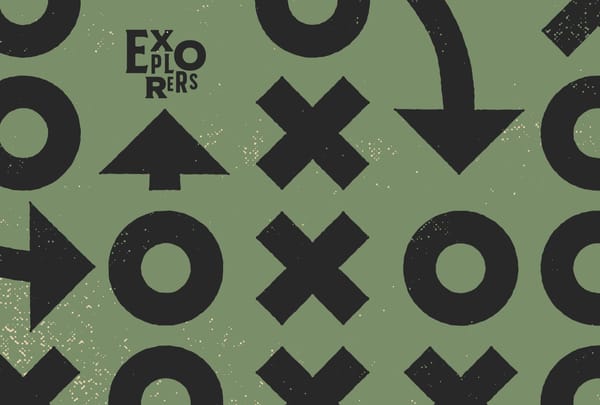The 1 HP Dragon
Combat as puzzles. A hack on the 16 HP dragon from Dungeon World.

My favorite thing about old-school play is its emphasis on creative problem-solving. It's one of the primary maxims of the OSR. "The solution is not on your character sheet." And, "Give players puzzles with no obvious or singular solutions." The problem is that, in my experience, the play culture and the systems they inherited have somewhat irreconcilable disagreements.
The OSR puzzle-solving works because of the expectations and culture set and reinforced by its community, procedures, and clever adventure design. But it is very easy—without introspection—to fall into the ruts and elision implied by the not-so-open-ended rules that hundreds of blogs have worked to interpret, reformulate, and codify.
But I love the idea of old-school play. Even if it never manifested as described.
So, I've been hacking away at a system with some challenging design goals. No arithmetic. No attack rolls. No hit points. No meta currency. Just sticky, open-ended puzzles covered in levers and buttons. The game I fell in love with in the late 90s, with all of its D&D DNA excised from it like a devil.
Under those conceits, combat has been difficult. This is the wishlist:
- No number crunching. That means no counting damage, comparing numbers, calculating modifiers, or subtracting damage.
- Dynamic story beats. Combat should have moments where it changes. I want failure, escalation, surprises, and comeback stories.
- Tactical storytelling. When I hear "tactical combat," it usually involves grids, special abilities, and counting distances. I want creative problem-solving without that. More: How do I hit this flying thing? Less: How do I proc my special move using my action economy?
Needless to say, I've been rereading old blogs and games to see if someone else has already done it. This brought me back to 2012 (holy crap) when I was obsessed with the concept of "a 16 HP dragon," described by Stras and highlighted by Sage LaTorra. The problem (for me) with a 16 HP dragon is that I've never been able to recreate it. I get close, but the system always takes over just like AD&D before it. For nearly 10 years, the 16 HP dragon has been my Quixotic ideal.
I still love the article and have run Dungeon World (and other games) with the knowledge and benefited from it. The challenge with a 16 HP dragon—or rather—the opportunity is that I think I can take it further. Remove the hit points. Remove the armor number. Remove the damage roll. Make the whole thing about "solving" the dragon. And finally, joust that windmill.
Naturally, I didn't stop there. I read about Nested Monster Hit Dice over on Mindstorm, Red Button Monsters on Playful Void, and dug into multiple games like Vaesen, Trophy, Mothership, and others. After releasing this article, I was reminded of 24XX by Jason Tocci and Dusk by Gila RPG. Both tackle this idea differently for different reasons. Needless to say, this is well-tread ground.
Puzzle box combat.
In all of the above examples, the puzzle is more abstract. It churns and evolves in the story, somewhere over everyone's head, in the collective fiction. In many ways, the combat lives separately from this puzzle.
For example, in Dungeon World, you expend resources and make moves so that you can get to the combat. The puzzle of reaching the dragon and finding the weapons to pierce its scales is legwork that leads to the combat roll. In a sense, the dragon is fighting the whole time (in Dungeon World, monsters attack as a consequence of failed rolls), but for players, "combat" is something you unlock by solving the puzzle.
In my game, I want the combat to end as soon as you solve the puzzle.
My current system most resembles what Idle Cartulary cooked on Playful Void. Great minds think alike. My system is a little more procedural—an evolution out of necessity for my tables.
The Monster Statblock
Monsters in this game are, in essence, checklists. I call these little action items on the checklist "lore" or "data." (I've been tooling with this for different genres, so naturally, the name of the mechanic changes.)
Most of the lore is your usual narrative stuff, like "wings that eclipse all before it" or "lays waste to towns," but you'll also get one type of lore or data called armor.
Types of Monster Armor:
- Legendary armor. This is the big stuff. The main plot armor. Not all monsters get legendary lore. They're locked behind quest-size puzzles of their own. Things like "Immune to all weapons" or "Soul is hidden away."
- Permanent armor. The more traditional armor you'd expect. This can be magical or mundane. It's permanent because it's always active under normal circumstances. I.e., the Black Knight's plate mail, a ghost's incorporeal form, blistering speed, or an absolute flood of goblins (sheer number can be a kind of armor).
- Situational armor. This is the stuff the monster does or has done to make them harder to defeat in combat. I.e., the dragon flying overhead, the kobold jabbing away with a long spear, and the rogue leveling a crossbow against your chest, ready to pull the trigger at any sudden movements.
Here's a rough example of a monster write-up in this game:
Benevolent the Dread, Red Dragon
Perilous threat. Paints himself a liberator.
Legendary Armor:
- Adamantium Scales (Immune to normal weapons)
- Rapid healing (Wounds fill in like lava in rock)
Lore:
- Crimson Thunderous wings
- Vomits forth fire and blood
- Adamantium claws
When the players come upon Benevolent, he'll likely be flying overhead and surrounded by fire (two very fearsome examples of situational armor).
Solving the monster.
The trick to this system is writing down the lore. Put the whole puzzle in front of the players. Never make the game challenge communication at the table. By making it physical and static, we create a baseline for everyone. All other nuances of interpretation either live and grow in the player's head or get brought up naturally when relevant. In other words, it keeps things concise, evocative, and easy to understand.
Depending on the table, I'll even place blank index cards on the table for undiscovered bits of lore and armor. Depending on the group, I might even give them a little hint. It all depends on who's playing. Either way, this procedure sharpens everyone's focus and (so far) leads to really exciting roleplay.
Here's an example of the armor being described in action:
"The red dragon beats his wings over the keep. Feeding the flames like infernal bellows. The ancient fortress splinters and melts before your eyes. Yet, for some reason, Benevolent waits patiently. Gloating."
The known armor, besides the legendary ones, are that he's flying over the keep and blocked off by fire. I write these down.
For some tables I don't have to put a third card (they're more than happy to be surprised). For others, I say "there's a third armor here, but you don't know what it is yet. For now, I'm just going to put down a blank card and write 'Waiting patiently. Gloating.' as a hint."
The third armor is that Benevolent has kobolds hiding among the ruins.
To defeat a monster or solve an encounter, players must narrate an attack that bypasses all the armor or try to negate them individually. Either way, they have to account for everything on the checklist. If they don't, they fail.
Usually, "solving" the armor provokes consequences, triggering die rolls. In this system, just like Powered by the Apocalypse or Pendragon, that's how harm is dealt to players. Either they fail rolls or don't react to obvious situations.
Combat usually takes two to three "rounds." Sometimes, I reveal the hidden armor that was keeping them from victory; other times, the monster reacts as a consequence of a failed roll and creates a new situational armor. It can be big, like a dragon launching into the air, or small, like a bugbear backing himself into a corner and swinging his flail.
Players can solve many of these problems by narrating what they do in the moment. A strong fighter might grab onto the dragon and climb onto his back. A rogue might come in fast and low under the bugbear's flail. Those actions sound dangerous, so they'll trigger die rolls, but sometimes the solution is a done deal. Maybe the players have a ballista ready, or the party wizard has a fireball to lob at the bugbear.
In this system, combat should be a puzzle with endless solutions. The only failure is if players say, "I'm going to use my sword on him again."
The benefits so far.
The system is a work in progress, but the results have been promising. In addition to generating more focused play and avoiding repetitive turns, I've noticed some trends in how my players interact with the world.
- Players know exactly how close or far they are from victory. If they can't come up with a solution, they know the best option is to retreat, regroup, and re-engage. And if they think they can still win, they're pushing their luck with all the cards on the table.
- Hidden lore is treated like leads in a mystery. Players are incentivized to investigate rooms in the dungeon, pore over ancient tomes, or hit up their local tavern for rumors. "I hear Benevolent is immune to all weapons. Is that true?"
- Unsolved armor sparks side quests and creative ideas. "If Benevolent is going to fly, maybe we need to create something that'll ground him, or maybe we take the fight to him in his underground lair?"
- Coordination is an intuitive solution. Players often solve encounters by combining their actions. Bards distract monsters. Wizards carve paths through fire with ice spells. Rogues sneak around obstacles. Fighters play interference.
Final Thoughts
It's still a work in progress. My next endeavor is simplifying. How do I design these puzzling monsters and NPCs in the fewest words? Where can I scaffold clues, consequences, and other interactive opportunities?
If you have games or articles that would help, send them my way. I'm sure someone has already done something similar. In this case, I'm more than happy to retrofit and flavor.
Explorers Design is a production of Clayton Notestine. If you liked this article, please consider liking, sharing, and subscribing. Members who pay just $5/month also get unlimited access to templates, tools, and resources.




